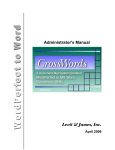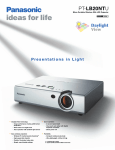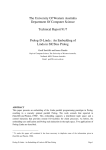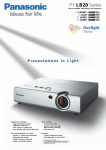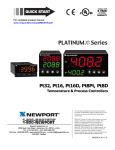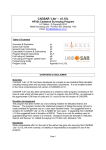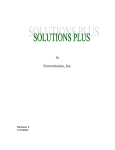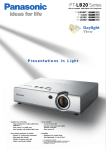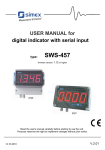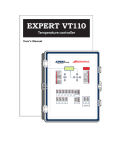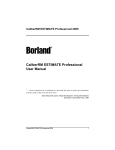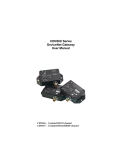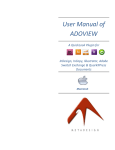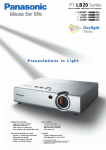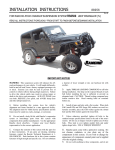Download Computing Stds Adv H SQP
Transcript
[C017/SQP161] Advanced Higher Computing NATIONAL QUALIFICATIONS Specimen Question Paper Answer questions from both sections: Section I and Section II. Section I: attempt either Question 1 or Question 2. Section II has three parts: answer questions from any one of the parts A, B, or C. There is a choice of questions in each part. Read the instructions at the beginning of each section. [C017/SQP161] 1 © SECTION I—Software Development and Computing Project Read the following text, and then answer either Question 1 or Question 2. A large lending library intends to develop new software to maintain records of its stock and customers, and to provide reports on demand. A working party has been given the job of overseeing the development and implementation of the software. The working party has produced the following statement of what is required of the software. The library has books located in three different buildings. In two of the buildings books are on public display and there are issue desks for borrowing and returning books. The third building is used to store books that are no longer kept on public display. Customers of the library are able to borrow books on public display, reserve books that are currently on loan, and inspect books kept in the store. The new software is required to maintain records of the history of each book, including locations, borrowers, condition, and dates of being borrowed and returned. In addition, records relating to each customer are required. These need to contain relevant personal or institutional details and a history of transactions. The software has to maintain and update these records. Various reports are required. At any time a request for the current status of any book may be generated by a member of the library staff or by a customer. Regular reports on library usage will be expected by the library management. Other reports should be triggered automatically when discrepancies are detected or when a customer does not return a book on time. The library has a multi-user computer system with basic terminals for customer use and with more sophisticated terminals located in offices and at issue desks for staff use. [C017/SQP161] 2 Page two SECTION I—Software Development and Computing Project Answer either Question 1 or Question 2. Read the text on Page two of this paper before attempting this question. Marks 1. (a) What is the difference between the statement produced by the working party and a formal operational requirements specification? 2 (b) In the context of the lending library, describe what a systems analyst would be expected to do to produce an operational requirements specification from the working party’s statement. 12 (c) After an operational requirements specification has been produced, describe the additional steps that will be required to produce a software design. 6 (d) (i) Name and describe a methodology which could be used to analyse a problem and document the results of the analysis. (ii) Show how your named methodology would be applied to the lending library. You may use diagrams to illustrate your answer. You are not expected to complete a design or code a solution. [C017/SQP161] 3 Page three 4 6 (30) SECTION I—Software Development and Computing Project Answer either Question 1 or Question 2. Read the text on Page two of this paper before attempting this question. Marks 2. (a) The external behaviour of a system is a description of what the system does in terms of its functions, inputs and outputs; the internal behaviour of a system is a description of how the system achieves its results in terms of the processes and methods that operate within it. Should an operational requirements specification specify external system behaviour, internal system behaviour, or both? Illustrate your answer using one feature of the new library software as an example. 4 (b) Describe the role of a project leader, systems analyst and programming team during the development of the system, giving examples of the activities they would perform. 10 (c) Describe one issue relating to the reliability of the software and one issue relating to the security of the data that arise from the fact that the library computer system is multi-user rather than single-user. With regard to each of these issues, in what ways could the software developers attempt to guarantee reliability and the security of the data? 8 (d) Those using the new software will require facilities to help them become acquainted with its capabilities. Describe two different methods by which the software itself could help users become familiar with its capabilities. Compare the advantages and disadvantages of these methods from the perspective of the library staff and the customers. [C017/SQP161] 4 Page four 8 (30) SECTION II Complete ONE part of this Section. Part A—Artificial Intelligence Answer TWO of the three questions in this part. Question 3 is compulsory. Answer either Question 4 or Question 5. Marks 3. (a) Two techniques for searching are exhaustive searching and heuristic searching. (i) Describe each technique. (ii) Compare the advantages and disadvantages of these two techniques. Your answer should make particular reference to efficiency and the effect of combinatorial explosion. (b) One application of the use of search techniques is natural language processing. (i) Name and describe an appropriate search technique for natural language processing. (ii) Parse the following sentence: “The old man likes crosswords.” using a parse tree or other method of representation. (c) Following a consultation with a user, an expert system is normally expected to offer some advice. Some expert systems offer the advice accompanied by a certainty factor. (i) Describe two benefits of using certainty factors. (ii) Give four reasons why some expert systems do not provide certainty factors. (d) You have been asked to advise on how the selection should be made between two expert systems produced using different expert system shells. For each of the following components of the expert system, describe two questions that need to be asked: • the knowledge base • the inference mechanism • the justification facilities. Explain how the answer to each question will be helpful in making the selection between the expert systems. [C017/SQP161] 5 Page five 4 6 4 4 4 4 9 (35) SECTION II Part A—Artificial Intelligence Answer either Question 4 or Question 5. Marks 4. In the puzzle known as the “Game of Five”, tiles numbered 1 to 5 are placed within a rectangular plastic frame containing a single empty space. A move is made by sliding a tile horizontally or vertically into an adjacent space. It is not permissible to lift a tile from the frame. The initial state and the required goal state of the puzzle are shown below. Initial State 1 2 4 5 Goal State 3 5 4 2 1 3 (a) The Game of Five is related to the popular Sliding Squares puzzle which uses a square frame containing 15 tiles. Give three reasons why a programmer who wishes to tackle the Sliding Squares puzzle might decide first to investigate the Game of Five. 3 (b) To represent the initial state of the Game of Five, the programmer chooses to use a list as follows: [1, 2, 3, 4, 5, 0] Using this representation, write down the lists which correspond to states that can be reached within one move from the initial state. 2 (c) The programmer decides to represent the legal moves by means of state transition rules. One such rule is as follows (list elements with upper case characters are variables). legal_move:[0, A, B, C, D, E]➞[A, 0, B, C, D, E] How many such rules are necessary to specify all possible moves which can be made in the Game of Five? Justify your answer. 4 (d) Draw a search tree which shows all the possibilities for the first three moves from the initial state shown. Do not include any move which merely reverses the previous move. Label each node with a list to represent the appropriate state. 5 (e) Mark your search tree to show the order in which the nodes will be searched by: (i) a depth-first search; (ii) a breadth-first search. 2 [C017/SQP161] 6 Page six Marks 4. (continued) (f) After consideration, the programmer decides against using either depth-first or breadth-first search methods. Why might these methods be unsuitable for the Game of Five? (g) A possible heuristic for the Game of Five is the inversions heuristic which assigns to each state a value equal to the number of pairs of inverted tiles occurring in that state. A pair of tiles is regarded as inverted if, in the state’s list representation, the larger numbered tile occurs before the smaller numbered tile. Note that in order to be considered inverted, the tiles do not have to be adjacent. In the list representation of the goal state of the puzzle, namely [5, 4, 3, 2, 1, 0] there are 10 such inverted pairs and so the evaluation of the goal state using the inversions heuristic is 10. (i) Annotate your search tree to show the evaluations computed by the inversions heuristic for each node. (ii) Name a search method which could make use of the evaluations and, by further annotating your tree, or otherwise, describe how a search using this method would proceed. (iii) If the heuristic search following this strategy fails to find a solution, what should the programmer do next? Describe two alternative courses of action which could solve the problem. 2 4 3 4 (h) The programmer eventually develops a program that can solve the puzzle for the initial state and goal state as specified above. However, when the program is modified for the initial state and goal state shown below, the search generates a memory overflow error. Initial State 1 2 4 5 Goal State 3 5 4 1 2 3 By reference to the number of inversions for this new goal state, or otherwise, explain why no modification of hardware or software will deliver a solution in this case. [C017/SQP161] 7 Page seven 6 (35) SECTION II Part A—Artificial Intelligence Answer either Question 4 or Question 5. Marks 5. (a) Monosoft Ltd wishes to develop an expert system to help its software technicians install operating systems for desktop computers. It is required that the expert system will run on portable machines carried on site. Monosoft Ltd hopes that the software technicians will be able to use the expert system to reduce installation time and assist in fault-finding. (i) Identify four factors which should be taken into account during the analysis of the feasibility of using an expert system for this purpose. Explain why each of these factors is significant. (ii) Should this expert system incorporate numerical certainty factors? Justify your answer. (iii) Describe two techniques which might be used to obtain information for the knowledge base of the Monosoft expert system. For each technique you have described, identify one advantage and one disadvantage. (iv) Describe the justification facilities which should be available in the completed expert system and discuss how these might affect Monosoft’s software technicians and customers. 12 3 6 6 (b) An environmental research group is investigating the effects of altitude, rainfall and soil type upon the erosion of landscape. The table below shows the presence or absence of an erosion hazard in some of the cases that have been studied. Altitude Rainfall Soil Type low high low medium low high medium low low medium medium high high high peat sand sand clay sand sand sand Erosion false false true false true true false Another way of representing this information is a decision tree. (i) Part of this decision tree is shown below. Complete the tree for the rest of the information table. 3 Altitude low high medium (ii) Compared to rules, what advantages and disadvantages are offered by a decision tree representation? [C017/SQP161] 8 Page eight 5 (35) SECTION II Part B—Computer Systems Answer TWO of the three questions in this part. Question 6 is compulsory. Answer either Question 7 or Question 8. Marks 6. (a) Name a microprocessor unit (MPU) with which you are familiar. For this MPU, name two different registers and describe the purpose of each register. 6 (b) What is meant by the terms instruction set and assembly language for an MPU? Explain why an assembly language program written for one MPU could not in general be used on a different type of MPU. 5 (c) A particular assembly language includes the following instructions. Instruction Meaning LOAD #C Load the (decimal) constant C into accumulator A STOR V Store the contents of accumulator A in variable V ADDA V Add the contents of variable V to accumulator A LODX #C Load the (decimal) constant C into the index register Increment the index register by 1 INCX STOX V Store the contents of the index register in variable V CMPX #C Compare the index register with the (decimal) constant C, and set the flag register with the result of the comparison BRGT L Branch to label L if the flag register is to set to a “greater than” state JUMP L Branch to label L unconditionally Consider the next section of assembly language program, and answer the following questions. Label LAB10 LAB20 [C017/SQP161] 9 Op Code LOAD LODX CMPX BRGT INCX STOX ADDA JUMP STOR ... Operand #0 #0 #99 LAB20 T T LAB10 S ... Page nine Marks 6. (c) (continued) (i) What would be the effect of removing the fourth instruction, BRGT LAB20? (ii) What would be the effect of removing the eighth instruction, JUMP LAB10? (iii) Explain the overall purpose of the above section of program. (iv) Describe the processes that have to take place before a section of program such as the one above can be executed by a microprocessor. (d) There are many different microcomputer operating systems available. Purchasers do not necessarily require to use a specific operating system for a particular processor. Describe four different criteria you would use to compare two microcomputer operating systems. Your answer should refer to specific examples. [C017/SQP161] 10 Page ten 2 2 4 4 12 (35) SECTION II Part B—Computer Systems Answer either Question 7 or Question 8 Marks 7. (a) Name a microprocessor unit (MPU) with which you are familiar. Describe the register structure of this MPU. You may use a text-based description or a block structure diagram or both. (b) For your choice of MPU, describe three different addressing modes that it supports. Explain, with reasons, which of these addressing modes would be most appropriate for: (i) referring to a single location in memory used by the operating system; (ii) storing and accessing a sequence of values in an array; (iii) using a jump or branch instruction to transfer control to a different part of a program. (c) In terms of the instruction set for your named MPU, describe a sequence of assembly language instructions to add together the values of two memory locations P and Q; if the sum is greater than 100 place the sum on a stack, otherwise assign the value 0 to each of the memory locations P and Q. (d) (i) Discuss the ways in which advances in integrated circuit technology have helped to contribute to improvements in microprocessor performance. Explain why there is a limit to such improvements with the silicon based technology currently used for commercially available microprocessors. (ii) Two computers are identical, except that the main microprocessors on their motherboards are different. Describe how you would compare the performance of the two microprocessors. [C017/SQP161] 11 Page eleven 8 3 3 3 8 7 3 (35) SECTION II Part B—Computer Systems Answer either Question 7 or Question 8 Marks 8. (a) Name two different operating systems with which you are familiar. Compare and contrast these two operating systems with respect to the provision that is made for: • customising the user interface; • installing a new peripheral device; • task switching; • recovering an accidentally deleted or corrupted file. 16 (b) A user wishes to install two different operating systems on a stand-alone microcomputer and choose which one to use when starting up the system. (i) Identify two ways in which incompatibilities between the operating systems may cause problems when using the new system. 4 (ii) Identify one issue that affects the user’s ability to choose which operating system to use when starting up the system. Explain how this issue could be resolved. 4 (c) A computer user installed a sound card in her computer. When she next started the computer it reported a device error. (i) One possible error could relate to a device driver. Describe the purpose of a device driver and its relationship to the hardware device, the operating system and application programs. (ii) Describe one possible way in which a device driver error might arise and explain how the error might be corrected. (iii) What other type of error might have been reported? If this were the case, explain how this error could be corrected. [C017/SQP161] 12 Page twelve 4 3 4 (35) SECTION II Part C—Data Communications Answer TWO of the three questions in this part. Question 9 is compulsory. Answer either Question 10 or Question 11. Marks 9. (a) Peer-to-peer and client-server are two types of networking that small companies may consider when installing a local area network. An analyst has included the following criteria: • number of platforms and protocols which can be supported • types of shared resources (hardware and software) • security of data • cost. (i) Compare peer-to-peer with client-server networks with reference to the criteria listed above. (ii) Name and describe two other criteria which are important when choosing a type of local area network. Give one reason for each choice of criterion. (b) The World Wide Web (WWW) is a recent client-server based Internet service. (i) Describe the historical developments in file transfer and remote access which have contributed to the development of the World Wide Web. (ii) Explain how the existence of standards has contributed to the development of the World Wide Web. (c) (i) Name and describe an existing local area network with which you are familiar. Give details of its hardware components and topology. (ii) For your named network, identify three components that a network manager would need to configure during its installation. [C017/SQP161] 13 Page thirteen 8 6 8 4 6 3 (35) SECTION II Part C—Data Communications Answer either Question 10 or Question 11 Marks 10. One definition of a network is “a set of nodes, connected by links, communicating data using a protocol”. The ISO/OSI Reference Model is a seven layer model that directly or indirectly relates to all networks. The table below illustrates how current protocols relate to this model. OSI TCP/IP Application FTP Presentation TELNET Session SMTP Transport TCP Network IP Data Link Ethernet Physical OSI TCP/IP FTP TELNET SMTP Open Systems Interconnection Transmission Control Protocol/Internet Protocol File Transfer Protocol TELetype NETwork Simple Mail Transfer Protocol (a) Different hardware devices work at different layers of the ISO/OSI model. (i) For each of the ISO/OSI layers given below, name a hardware device that operates at that layer. You must choose a different device for each layer. • Physical layer • Data link layer • Network layer (ii) Describe in detail the function of each named device. (b) Communication protocols in the Data Link layer of the ISO/OSI model incorporate techniques for detecting transmission errors. (i) Give two examples of techniques for detecting errors and compare the benefits and limitations of your chosen techniques. (ii) In each case, identify types of transmission error that the technique fails to detect. [C017/SQP161] 14 Page fourteen 3 9 4 2 Marks 10. (continued) (c) Local area networks based on a bus topology are likely to adopt different protocols from those based on a ring topology. (i) Explain why these topologies use different protocols. (ii) At which layer in the ISO/OSI model do these differences occur? (iii) With reference to a network of your choice, describe briefly the operation of four protocols which operate above the physical layer. (d) A computing company wants to go on tour, demonstrating their latest software with a file server and a range of battery-powered notebook computers. Clients participating in their software training days use the notebook computers to connect to the file server to access resource files for their training. Describe one recent development in network connectivity which would be appropriate for this situation. Identify any associated standards which would be necessary for this type of connectivity. [C017/SQP161] 15 Page fifteen 6 1 4 6 (35) SECTION II Part C—Data Communications Answer either Question 10 or Question 11 Marks 11. Many large supermarket chains are now issuing customers with hand held terminals (HHTs) which benefit both customer and store management. As a customer shops, the HHT is used to read the bar code on items and total the customer’s bill. The HHT queries the database on the store’s local area network to determine item prices. When the customer reaches the till, the HHT is handed to the cashier and the bill is printed. The HHTs communicate with the store’s local area network (LAN) using low powered radio transmissions. The low powered radio system makes use of fixed transceivers that are located all round the store, connected to the LAN. Each transceiver has a range of 10 metres and communicates with the HHTs in its immediate vicinity. As customers move around the store, their HHTs will link to different transceivers at different times. Several HHTs can be within the area reached by a single transceiver simultaneously. If two or more HHTs try to communicate with the same transceiver such that their transmissions overlap in time, all the overlapping transmissions will fail. Transmissions from different transceivers use separate radio channels and always succeed. (a) Describe a protocol that the transceiver and HHTs could use to ensure that transmissions from a HHT to the transceiver are successful. (b) (i) Name an alternative communication technology that could be used to link the hand held terminal to the store’s LAN. (ii) Compare your alternative technology to the store’s use of radio, giving one advantage and one disadvantage of each technology. (c) The supermarket chain hopes to widen its range of services to include e-mail, on-line shopping and banking. (i) Explain the role of SMTP, TCP/IP and POP3 in the transfer of e-mail between computer systems. (ii) Describe a situation where MIME may be used when sending mail messages. (iii) Data compression is a vital component of many file transfer and other data communication applications. Name one data compression technique and indicate, with reasons, a suitable application for that technique. (d) When data is being transferred between different LANs belonging to the supermarket chain, the use of IP addresses is essential. (i) What is the purpose of an IP address? (ii) Explain the notation of the following IP address: 195.188.148.3 (iii) Describe the purpose of the domain naming scheme and illustrate how domain names relate to IP addresses. You may use an annotated diagram in your answer. (e) What constraints operate in the way IP addresses are assigned? [END OF QUESTION PAPER] [C017/SQP161] 16 Page sixteen 6 1 4 9 2 4 1 2 3 3 (35) [C017/SQP161] Advanced Higher Computing NATIONAL QUALIFICATIONS Specimen Marking Instructions [C017/SQP161] 17 © COMMENTARY ON PAPER Structure of paper The written examination will comprise of a single paper. The paper will consist of a mandatory section (30%) and an optional section (70%) comprising questions for each of the optional units. Candidates will be provided with a choice of question within each section. Distribution of marks The paper will be worth 100 marks, distributed as follows: Section I 30 marks Section II 70 marks Section I This is based on the mandatory units: Software Development and Computing Project. It consists of two extended response questions. Candidates must choose one of the two questions. Each question will be derived from the same single scenario, to minimise the time required for reading the question context prior to making a question choice. Each question will be worth 30 marks. Questions will be drawn from Software Development, in the main; assessment of Computing Project outcomes can be in general terms only. Section II Parts A, B, C Each part provides questions for one of the options: • Artificial Intelligence • Computer Systems • Data Communications Candidates must choose one of the optional parts only. Each part has one compulsory question worth 35 marks, and a choice of two optional questions, also each worth 35 marks. Candidates must answer only one of the optional questions. The compulsory question will assess principally knowledge and understanding, and will sample across all outcomes of the component unit. Each optional question will assess problem solving skills as well as knowledge and understanding, allowing candidates the opportunity to demonstrate the application of an analytical approach and skills in more complex contexts, integrating skills in less familiar contexts. [C017/SQP161] 18 Page two SECTION I—Software Development and Computing Project Question 1 Marking Instructions 1. (a) The statement produced by the working party is a non-technical document expressed in terms of general characteristics that the software system should exhibit. The Operational Requirements (OR) specification is a technical document expressed in terms of systems requirements which can be tested. Marks: 2 marks for stating above or other valid identification of difference. (b) The systems analyst would be expected to do the following to produce the OR specification: (i) Construct a problem specification to summarise the reason for the analysis, define the level at which analysis would be conducted and the scope of the problem, identify the information that would need to be collected and the sources of this information, and outline a schedule for the analysis. The scope is an important aspect to be agreed. For example, the book purchasing system and the payroll system for library staff would not feature in the investigation; the book classification system, the existing computer system, and the loan recording system clearly would. Seek agreement of the working party with the problem specification. (ii) Perform a system investigation to consider what must be done to solve the problem; the analyst would need to gather information from various sources, eg Interviews with library staff to obtain information about current operations and procedures and views as to what the new software should provide. Interviews with customers to ascertain the usefulness of current software for searching for authors and/or titles, and what features they would like to have in addition. Observation of staff and customers using the library. Weaknesses of the current software provision may become apparent even though not identified in interviews. Questionnaires to collect information relating to specific aspects of the existing system. For example, a questionnaire could identify who needs to access customer records, how often these need to be accessed, how frequently they need to be updated, what the information would be used for, what specific information would be required, and so on. Existing outputs. GUIs and reports would be examined to gain a better understanding of the type and flow of information within the library. How reports are used, how they are stored, and the sensitivity and importance of the information would all be examined. (iii) Produce the OR specification by analysing the gathered information and organising it so that it can be viewed in proper perspective. The OR specification should be written precisely to form the basis for a contract between the library management and the software developer, and expressed using a terminology that both parties can understand, in functional and nonfunctional terms. Marks: for each aspect of analyst’s role, describe action (2 marks) and place in context (2 marks). Alternative answers could include description and purpose of feasibility study. [C017/SQP161] 19 Page three 1. (continued) (c) Analyse the operational requirements: examine the specification in preparation for the design of the system, to determine fully what the software must do. Produce the system specification, describing the hardware and software requirements of the system, including details of operating system software, applications software and data, systems hardware, and any installation and training requirements. Produce the software design itself, for example by identifying the major modules and data communications, data structures, and a logical decomposition of modules into sub-modules. Marks: expect three points adequately described, 2 marks each. (d) (i) Describe an identifiable methodology, for example for a structural/functional approach such as with Yourdon: • process analysis is performed to identify and model the processes which take place in the context of the system required; depict this with the data flow diagrams; • data analysis is performed to identify and model the data and its organisation; depict this with entity relationship diagrams; • analyse the control of processes and timing of events; model this sequence with a state transition diagram; • validate the models against each other. If an object-oriented approach is described, techniques should describe modelling static and dynamic components, depicting the models using use case diagrams, class diagrams, object interaction/sequence diagrams and state transition diagrams, as with UML. Marks: expect four key aspects of methodology adequately described, 1 mark each. [C017/SQP161] 20 Page four 1. (d) (continued) (ii) The specific collection of models involved should be given in the context of the library system, for example: management library staff book status report library usage report book request personal details library system book request customer book status report context diagram showing system and main external entities; personal details update customer file 1 customer record customer file customer record book request generate book report book status report book record 2 book file library usage report generate usage report book record 3 part of data flow diagram showing main processes, files and data flows; [C017/SQP161] 21 Page five 1. (d) (continued) EACH TIME ACTIVATED WAITING FOR STAFF NOT “VALID PASSWORD ENTERED” “TERMINAL ACTIVATED” “VALID PASSWORD ENTERED” A: “GET PASSWORD” T: “GET REQUIRED SERVICES” PROCESSING STAFF part of state transition diagram showing time sequence of processes. Marks: six marks for illustrating modelling of data, processes, and timing (or other aspects if a different methodology described in part (i)) in the context of the library system. Profile of question 1 Outcome KU (a) 1(a) 2 (b) 1(a), (c) 6 (c) 1(b) 6 (d)(i) 2(a), project 2 4 (d)(ii) 2(a), project 1 TOTAL [C017/SQP161] 22 6 6 18 Page six PS/AA 12 SECTION I—Software Development and Computing Project Question 2 Marking Instructions 2. (a) It should specify external system behaviour. It is not a design document: it should set out what the system should do without specifying how it should be done. For example, one functional requirement of the library software might be a facility for a customer to perform a keyword search for book titles. The OR specification should identify this function, specify user i/o and data i/o in abstract terms. It should not, however, describe the details of the user interface nor should it describe the search method to be adopted. Many other examples would be valid. Marks: correct answer with valid explanation (3 marks) given in library context (1 mark). (b) Project leader: role is to plan and supervise the project development and work. Activities include production of proposal, schedule, budget, quality plan, organisation of monitoring and review meetings/inspections, production of reports and selection/appraisal/release of staff. Systems analyst: role is to conduct the investigation, identify information flow and processes and produce an operational requirements document. Activities include interviewing library staff and customers, sampling information sources such as existing reports and borrowing records, observing how library loans are processed, noting communication between sub-systems such as issue and storage systems. Programming team: role is to translate design into robust code with an acceptable level of defects. Activities include coding, designing interfaces, evaluating interfaces, testing, documenting code, documenting test results, attending meetings (including reviews/inspections), producing user documentation, and training. Marks: 2 marks for project leader role and activities, 4 marks for each of others. (c) Reliability: the software will fail in due course if the design does not consider the problem of simultaneous editing of a file or record, eg when two customers attempt to simultaneously reserve a book. The design should provide for file locking or record locking and the implementation should be followed by appropriate testing. Complete assurance about issues such as this would not be achieved until after extensive testing of the whole system. Security: there is a potential problem of unauthorised access to program or data files, eg a customer attempting to modify his or her record, or a hacker attempting to introduce a virus. A solution may be to provide password access for different levels of usage of the software. This would require a modification of the OR specification plus consequent design and implementation changes. Marks: for each issue: description (2); solutions (2). (d) Could identify any of the following (other legitimate methods could substitute). • An online tutorial facility. Particularly for new users a tutorial facility will guide the user through the basic features of the software. It shows dynamically on the screen how different features are activated and what the effect is in each case. This would be suitable for library staff who will use the system extensively and for whom time spent early on following a tutorial will pay dividends later. For a library customer, who may visit the library only rarely, such a system might be a frustrating consumer of time. [C017/SQP161] 23 Page seven 2. (d) (continued) • A context-sensitive help provision. At its most basic, this might be a description of all the features of the software, indexed for ease of access. More sophisticated examples will provide facilities to display guidance on a particular feature while it is being used, using simple keystrokes or button selection. This system is usually valuable for a user who merely needs reminding of the functionality of the system. If it is well designed, it can also help new users, by enabling them to display guidance about a feature with which they are unfamiliar. Thus such a provision could benefit both staff and customers. There could also be a facility to display a succinct reminder of the purpose of a particular screen object whenever the mouse pointer pauses over it, but without activating the object. This would be of benefit to the regular customer, but of less benefit to the irregular user of the library, for whom a brief tip might be too cryptic. The new user, particularly if not computer-literate, would require some additional guidance, either in the form of a printed user-manual, or in tutorials presented by library staff. Marks: 2 marks for description, 2 marks for advantages and disadvantages, for each of two methods. Profile of question 2 Outcome KU PS/AA (a) 1(a) 3 1 (b) 1(c), (b) 7 3 (c) 1(b), project 1 4 4 (d) 1(b), project 1, 2 4 4 18 12 TOTAL [C017/SQP161] 24 Page eight SECTION II—Artificial Intelligence Question 3 Marking Instructions 3. (a) (i) Exhaustive searching is a systematic problem-solving technique which tries to find a solution by examining all possible solutions. Heuristic searching uses hints, tricks, rule of thumb or knowledge about the state space to limit the search process and eliminate a lot of wasted searches. Marks: up to 2 marks for each technique’s description. (ii) Since an exhaustive search examines all possible solutions it can, in many situations, be very inefficient because of the time and processing power required (1). It should however find the best solution, if a solution exists (1). A disadvantage is that in some cases the number of possible combinations that need to be considered increases exponentially and will exceed the capacity of the computer system thus causing a combinatorial explosion (1). A good heuristic search can be very efficient since it reduces the time needed to find a solution (1). Since this method drastically restricts the number of possible solutions needing to be considered at each stage the effect of combinatorial explosion is reduced and the solution is found faster (1). The disadvantage of this searching is that although there is a guarantee of finding a solution, if one exists, it is not necessarily the best one (1). Marks: 6 marks (b) (i) The search technique used in natural language processing is depth-first search (1). If the initial state is the goal state, quit and return success (1). Otherwise select an alternative until the goal is reached or a node is reached where no further downward motion is possible (1), in which case the search is restarted at the nearest ancestor node with unexplored children (1). Marks: 4 marks (ii) sentence noun phrase verb phrase determiner adjective noun verb noun the old man likes crosswords Marks: 4 marks. Deduct 1 mark for each mistake. [C017/SQP161] 25 Page nine 3. (continued) (c) (i) The benefits that can be claimed for the provision of certainty factors are: • uncertainty is often present in the domain expertise (1), and the provision of certainty factors enables this to be directly represented (1). • uncertainty is often present in data that is supplied at run time (1), and the provision of certainty factors enables this to be directly represented (1). • the provision of certainty factors enables users to be given an indication of how strongly supported is the conclusion that is reached by the expert system (1), which should increase their confidence in the system’s validity (1). Marks: 2 marks for each benefit up to a maximum of 4 marks. (ii) Some expert systems do not provide certainty factors because the domain and runtime information may be completely known; certainty factors may be considered to be unhelpful to users; not all KBS development environments support certainty factors; some developers believe that certainty factor methods are wrong; certainty factor values may be difficult to obtain. Marks: 1 mark for each reason up to a maximum of 4 marks. (d) Each bullet point should have two questions, suitably justified in terms of its helpfulness in making a selection. The knowledge base—two questions, such as: Question: Is it complete? That is, does it contain all the information which human experts consider necessary? This is a helpful question because if information is missing then some classifications may not be possible. Question: Is it sound? That is, does each item of knowledge correctly describe an aspect of knowledge? This is a helpful question because if some item of knowledge is incorrect then some classifications may be invalid. Question: Can the knowledge base be interfaced to external databases? For example, can information on personal details that is already held in a database be incorporated? This is a helpful question because such a capability will reduce the need to re-key existing facts or to maintain additional copies of these. Question: Is it constructed in a way which will facilitate maintenance? This is a helpful question because the knowledge base is likely to need updates in future. The inference mechanism—two questions, such as Question: Is it complete? That is, is it guaranteed to produce a classification whenever one is justified by the data and knowledge base? This is helpful because an inference engine which is capable of going into a loop or runs out of memory (for example) may cause the expert system to be unreliable. Question: Is it acceptably fast? This is a helpful question because the expert system may be required to cope with a large number of cases every day. If it is too slow it may act as a bottleneck. Question: Can it operate with missing or uncertain information? This is a helpful question because cases of missing or uncertain information may be common and these should be processed as far as the available information permits. [C017/SQP161] 26 Page ten 3. (d) (continued) The justification facilities—two questions such as: Question: Does the system have a full set of justification facilities, including the capacity to justify conclusions as well as the capacity to explain the relevance of questions? This is helpful because a system with such facilities is likely to be more highly valued by its operators. Question: Are justifications presented in a way that is flexible and intelligible to the operator, for example by relating explanations to familiar domain concepts and by allowing the quantity of detail in the presented information to be selected? This is helpful because high quality justifications will make the system more effective in use. Marks: for each component—1 mark for pair of valid questions; 1 mark for each question’s explanation. Profile of question 3 Outcome KU (a)(i) 1(a), 2(b) 4 (a)(ii) 2(b) 6 (b)(i) 2(b), (c) 4 (b)(ii) 2(d) (c)(i) 3(a), (b) 4 (c)(ii) 3(a), (b) 4 (d) 3(b) 3 6 25 10 TOTAL [C017/SQP161] 27 Page eleven PS/AA 4 SECTION II Part A—Artificial Intelligence Question 4 Marking Instructions 4. (a) The Game of Five is a simpler puzzle than the Sliding Squares, but it is of the same general kind (1). Because it is simpler, solution methods may be easier to discover (1). Because it is of the same kind, it may be possible to abstract the methods that are discovered so as to solve the larger puzzle (1). Marks: 3 marks. (b) [1,2,3,4,0,5] and [1,2,0,4,5,3] Marks: 1 mark for each answer. (c) The rule LHS has 6 forms (4 corner forms + 2 centre forms) Each corner form LHS has 2 RHS forms (centre + corner) Each centre form LHS has 3 RHS forms (centre + 2 corner) Hence number of rules required = 4 × 2 + 2 × 3 = 8 + 6 = 14. Marks: 1 mark for 14. 2 marks for a justification that is correct but inelegant, eg exhaustive enumeration. For full 3 marks for justification, should be along the lines above. (d) A search tree (with loop-free branches) is: [1,2,3,4,5,0] [1,2,0,4,5,3] [1,0,2,4,5,3] [0,1,2,4,5,3] [1,5,2,4,0,3] [1,2,3,4,0,5] [1,2,3,0,4,5] [0,2,3,1,4,5] Marks: 5 marks. [C017/SQP161] 28 Page twelve [1,0,3,4,2,5] [0,1,3,4,2,5] [1,3,0,4,2,5] 4. (continued) (e) DF1 BF1 [1,2,3,4,5,0] DF2 BF2 [1,2,0,4,5,3] DF6 BF3 [1,2,3,4,0,5] DF3 BF4 [1,0,2,4,5,3] DF4 BF7 [0,1,2,4,5,3] DF7 BF5 [1,2,3,0,4,5] DF5 BF8 [1,5,2,4,0,3] DF8 BF9 [0,2,3,1,4,5] DF9 BF6 [1,0,3,4,2,5] DF10 BF10 [0,1,3,4,2,5] DF11 BF11 [1,3,0,4,2,5] Marks: 2 marks. (f) The tree is quite large (there could be up to 6! = 720 states so branches may be very long). DF and BF will try to search the tree exhaustively. This may require more time and/or memory than is acceptable. Marks: 2 marks. Award one mark for a less full explanation. (g) (i) 0 [1,2,3,4,5,0] 0 [1,2,3,4,0,5] 2 [1,2,0,4,5,3] 2 [1,0,2,4,5,3] 2 [0,1,2,4,5,3] 0 [1,2,3,0,4,5] [1,5,2,4,0,3] 4 2 [0,2,3,1,4,5] 2 [1,0,3,4,2,5] 2 [0,1,3,4,2,5] [1,3,0,4,2,5] 2 Marks: 4 marks. Deduct 1 mark per error or omission. (ii) Any standard heuristic search method eg hillclimbing, best-first, or beam, could be named. A hillclimbing search proceeds as follows: determine the successors of the current node; evaluate them heuristically; select the most favourable (here, the one with highest evaluation) as the new current node. Marks: 3 marks. Normally 1 for naming and 2 for describing, but no penalty for the candidate who provides a perfectly good description of a heuristic method, but fails to name it correctly. (iii) Courses of action—1 mark for each action and 1 mark for each exemplification. Change the search algorithm, eg from hillclimbing to best-first. Change the heuristic, eg from the inversions heuristic to a heuristic based on counting misplaced tiles. Change the hardware, eg to a computer with a faster CPU and/or more memory. Marks: 4 marks. [C017/SQP161] 29 Page thirteen 4. (continued) (h) Hardware and software modifications are pointless because it is impossible to reach this new goal state from the start state by any sequence of legal moves (1). The annotations shown in (g)(i) suggest that states reachable from the start state all have an even number of inversions (1). This goal state has 9 inversions and so a state with 9 inversions is not reachable (1). Marks: 3 marks. The following argument proves that the parity of inversions is an invariant of the search. ← CASE 1: Corner corner moves 0 T1 T2 T3 T1 T2 T3 T4 T5 0 T4 T5 If the pair (T1, T3) was an inverted pair before the move, it is not one after the move. Hence this pair contributes a difference of one to the total number of inversions. Similarly for the pair (T2, T3). No other pair is affected. Hence the number of inversions changes by two, ie no overall change in the parity of inversions. Similarly, the other corner corner moves reverse two inversions and so do not change the parity. ← middle and middle ← ← CASE 2: Corner corner moves 0 T1 T2 T1 0 T2 T3 T4 T5 T3 T4 T5 T1 0 T2 0 T1 T2 T3 T4 T5 T3 T4 T5 These moves make no change to the list sequence of tiles, which is: [T1, T2, T3, T4, T5]. So the number of inversions is unchanged. Similarly for the other corner middle moves—no parity change. ← [C017/SQP161] 30 Page fourteen 4. (h) (continued) ← CASE 3: Middle middle moves T1 0 T2 T1 T4 T2 T3 T4 T5 T3 0 T5 Two pairs (T4, T2) and (T4, T3) have reversed inversions. Hence no change in the parity of the number of inversions. Similarly for the other middle middle moves. Marks: 3 marks. Partial credit of up to 3 marks can be awarded for an explanation that falls short of a correct and complete proof. ← Profile of question 4 Outcome KU PS/AA (a) 1(b) 1 2 (b) 1(b) 2 (c) 1(b) 4 (d) 2(a) 1 (e)(i) 2(b) 1 (e)(ii) 2(b) 1 (f) 2(b) 1 (g)(i) 2(d) (g)(ii) 2(b) 2 (g)(iii) 2(b) 4 (h) 2(b), 1(c) TOTAL [C017/SQP161] 31 1 4 1 6 11 Page fifteen 4 24 SECTION II Part A—Artificial Intelligence Question 5 Marking Instructions 5. (a) (i) Technical factors: The expert system must be able to run on a portable PC platform. It will have to be decided whether the installation process is complicated enough to justify building an expert system, and whether the installation problems encountered by software technicians are similar enough to make it likely that an expert system will help. Technical factors may determine which, if any, expert system is chosen. Knowledge representation factors: Expert system shells tend to make use of one particular knowledge representation system. The knowledge engineer must choose one which best fits the type of knowledge to be represented. The expert system shell chosen is significant because this will determine such features as cost, the user interface, and technical support. Economic factors: Does the cost of developing the expert system justify the savings in support costs? Will development of the expert system delay the implementation of the operating system? On the positive side, building the expert system will in itself help the company to improve their installation instructions and training materials. Economic factors are significant in a feasibility study because they will determine whether or not the project goes ahead. Social factors: A possible effect on the status of the software technicians is to de-skill them. The technical expertise of the knowledge engineer also has to be taken into account as time may be needed to become familiar with the operating system which is the subject of the proposed knowledge base. These factors should be considered in a feasibility study because they will affect the time scale for the implementation of the project. Marks: candidates should identify 4 factors. 1 mark for identifying each factor, 2 marks for explaining its significance as above or for valid alternatives. (ii) Numerical Certainty factors are unlikely to be necessary in this particular application. The system developed is likely to be a fault diagnosis one where known possible faults are investigated, and their causes determined by a series of specific tests or questions which can elicit complete information that is certain. Numerical Certainty factors are more likely to be of use in systems such as medical diagnosis, where it is often difficult to determine precisely the causes of a particular problem. Marks: 1 mark for statement of whether factors are necessary or not, 2 marks for justification which contains at least the level of detail above. If valid reasons are given, then marks should be awarded for the opposite viewpoint. [C017/SQP161] 32 Page sixteen 5. (a) (continued) (iii) Three techniques are as follows. Interviewing by a knowledge engineer of personnel skilled in the installation process. Advantages of this technique are its directness and the availability in this case of suitable experts, viz. operating systems specialists. Disadvantages are the time consuming nature of encoding knowledge from the information received. The interviewer will also need to be familiar with, or acquaint themselves with, the knowledge area. Articulate experts are required. Case study analysis by knowledge engineer of previous record of installation experiences. Advantage is that information from past records may be readily and cheaply available. Disadvantage is that a sufficient set of cases may not be available to allow for a representative analysis. Reading by the knowledge engineer of installation instructions and manuals. Advantages are that the information is likely to be well structured and accurate in such documents. Disadvantages are that such documents may not pinpoint useful cases and often assume specialist prior knowledge on the reader’s part. Marks: candidates should describe 2 techniques. 1 mark for a description of each technique, 1 mark for the advantage and 1 mark for the disadvantage. Alternative valid answers are equally acceptable. (iv) Response should include both how and why justification. How justification will explain the route through the knowledge base which has resulted in the conclusion reached. Why justification will explain why a particular question is being asked, and what may be proved by possible answers to it. Technicians—The justification facilities of the expert system can be used to support the training of software technicians, as they can use it to discover why errors have arisen and gain a more thorough understanding of the process from querying the questions they are asked (Why justification) and the advice they are given (How justification). Justification facilities will also give the technician confidence in the strategies suggested by the expert system. Customers—The justification facilities should lead to more reliable, lower cost and faster upgrades to the customers’ computer systems. If the customers make use of the justification facilities themselves, they may avoid the cost of calling out a technician, and improve their understanding of the installation and fault finding process. Marks: 2 marks for full description of justification facilities and 4 marks for detailed description of effects. [C017/SQP161] 33 Page seventeen 5. (continued) (b) (i) Altitude low Rainfall low medium high medium Erosion hazard = FALSE Rainfall high low Erosion hazard Erosion hazard Erosion hazard = TRUE = FALSE = TRUE high Erosion hazard = FALSE Erosion hazard = TRUE Marks: 3 marks for any correct decision tree, eg as per the optimised tree above, but optimisation is not essential. Deduct 1 mark per error. (ii) Advantages—a decision tree: • provides a coherent representation of information; • is more concise—tree has 9 nodes—rule set has 28 conditions and conclusions; • makes certain features of the information visible eg medium altitude—no erosion; • provides a straightforward procedure for classifying cases—unlike rules, no search is required; • shows up conflicting data. Disadvantages—a decision tree: • is difficult to extend. If a new case comes to light then it is easy to incorporate it as a new rule whereas the tree may need major surgery; • in electronic form, a tree needs special graphical editing tools, with rules any text editor will do; • is not modular. A rule is a self-contained item of knowledge whereas a tree is a tightly integrated structure; • is difficult to validate if large; • can’t usually be run directly—needs to be compiled into a runnable (eg rule) form. Marks: 1 mark for each of 5 advantages or disadvantages. Profile of question 5 Outcome KU PS/AA (a)(i) 3(b) 4 8 (a)(ii) 3(a) (a)(iii) 3(b) 2 4 (a)(iv) 3(a) 2 4 (b)(i) 2(a) (b)(ii) 2(a) TOTAL [C017/SQP161] 34 3 3 5 13 Page eighteen 22 SECTION II Part B—Computer Systems Question 6 Marking Instructions 6. (a) Any MPU may be named, eg Motorola 68000. No marks for naming MPU, but marks may be lost if the registers named do not conform to the MPU. Any valid registers can be described, eg Memory Address Register. There are eight of these, each used to hold the address of the memory location to or from which data is to be transferred. Memory Data Register. There are eight of these, each used to hold data about to be transferred to a memory location, or to receive data being transferred from a memory location. Marks: in each case, 1 mark for name and 2 marks for description. (b) The instruction set is the set of legitimate machine instructions for a particular microprocessor, each usually consisting of an operation code and an operand. A machine code program comprises a sequence of instructions drawn from the instruction set (2 marks). On a computer the machine code program is stored in memory locations in binary form. To assist human understanding the same program may be represented using mnemonics for opcodes and decimal or hexadecimal numbers or symbolic values for operands. This representation of instructions using mnemonics and symbolic values is called assembly language (1 mark). There is a one-to-one relationship between an assembly language instruction and the corresponding machine instruction. An assembler is used to translate from one to the other. In general two different MPUs will have two different instruction sets. Consequently the machine code program produced by an assembler for its associated MPU will not contain instructions that can be understood by another different MPU (2 marks). Marks: 2 marks for instruction set description, 1 mark for assembly language description, 2 marks for relationship explanation. (c) (i) An infinite loop would develop, with control repeatedly returning to the instruction labelled LAB10 (2 marks). (ii) All instructions between LAB10 and LAB20 would be executed once only, and the intended repetition of instructions would not take place (2 marks). (iii) It sums the first 100 integers and stores the result in the variable S. On completion the index register contains the value 100, as does the variable T, and the accumulator contains the value of the sum. (4 marks) (iv) The code has to be assembled, during which the assembly code is translated into machine code, taking account of any assembler directives (1 mark). Linking has to take place, during which various modules and libraries which are required by the program are linked together by a linker or link-editor. The linker has to check that each cross-reference between modules is satisfied (2 marks). After translation and linking the program has to be loaded into computer memory prior to execution, and then the address of the first program instruction is placed in the program counter to force execution to commence (1 mark). Marks: 2 marks parts (i) and (ii). 4 marks for parts (iii) and (iv). [C017/SQP161] 35 Page nineteen 6. (continued) (d) Possible criteria for comparison of operating systems are as follows. GUI/HCI Is there a graphical user interface, and how well is it designed? Is it part of the operating system (eg Windows 98) or just loaded on top of it (eg Windows 3.1)? Is the windows/desktop metaphor an intuitive one which mirrors the logical filing system (eg Mac) or is it just a program launcher (eg a graphical shell)? Multitasking Is multitasking available? Can you format a disk, print a document, etc, as a background process whilst executing other tasks (eg UNIX) or must you wait for them to finish (eg early 8-bit machines)? Backwards compatibility Is the operating system backwards compatible with earlier versions (eg successive releases of MS-DOS) or is it likely that applications designed for earlier versions will not run? Peripheral Support Is a wide variety of device drivers available? Is the user community large enough to ensure that drivers for new peripherals (eg new modems, soundcards, printers, scanners) will be readily available in the future? Commercial considerations How much does the operating system cost, both to purchase and maintain? Is there likely to be support in the future for bug-fixes, upgrades, etc? Is the manufacturer likely to lose interest and withdraw support when new versions of the operating system are introduced in future? Is there a sufficient body of user applications being generated? Other valid criteria acceptable. Candidates should describe four different criteria. Marks: for each criterion: 1 for identification, 1 for description, 1 for appropriate use of examples. Profile of question 6 Outcome KU (a) 1(a) 6 (b) 2(a) 3 (c)(i) 2(c) 2 (c)(ii) 2(c) 2 (c)(iii) 2(c) 4 (c)(iv) 2(d) 4 (d) 3(a), (b), (c) 12 TOTAL [C017/SQP161] 36 25 Page twenty PS/AA 2 10 SECTION II Part B—Computer Systems Question 7 Marking Instructions 7. (a) Eg Motorola 6809. This has two 8-bit accumulators, A and B, which may be used separately or may be manipulated as a single 16-bit accumulator, D. There are two 16-bit index registers, X and Y. There are two 16-bit stack pointers, S and U. S is used to maintain the system stack. U is available to the programmer, and is known as the user stack. Both stack pointers can be used as extra index registers. There is an 8-bit direct page register which supports a short form of absolute addressing. Finally the 8-bit condition code register contains 8 flags, including the carry and arithmetic overflow bits. Marks: 8 marks. (b) (i) referring to a single location in memory used by the operating system: Absolute mode. In this mode an absolute memory address is specified by the two bytes that follow the op code. Since there is an explicit reference to a specific memory address this method of addressing might not be appropriate for an application program, for which the position of data in memory might not be known before program execution. However, for a single memory location used by the operating system this might be very appropriate, since it provides rapid memory access. Marks: description 1 mark, explanation 2 marks. (ii) storing and accessing a sequence of values in an array: Indexed mode. In this mode the effective memory address is given by the one or two bytes that follow the op code plus the contents of an index or stack register. If the bytes following the op code contain the address of the start of an array, then the index register can be incremented to access each array component in turn. Marks: description 1 mark, explanation 2 marks. (iii) using a jump or branch instruction to transfer control to a different part of a program: Relative mode. The effective memory address is the contents of the program counter plus an offset specified by the one or two bytes that follow in the op code. This method of addressing is most appropriate for branching within a program, since the precise locations of program instructions in memory are not relevant. Marks: description 1 mark, explanation 2 marks. (c) LDA P ADDA Q CMPA #100 BGT L1 LDA #0 STA P STA Q BRA END L1 STA R LDU R END ... Marks: identifying appropriate MPU instructions (4); correct logic (4). [C017/SQP161] 37 Page twenty-one 7. (continued) (d) (i) By reducing the widths of the channels etched onto the silicon substrate, circuits can be packed closer together. This means that the distance that current has to travel between components can be reduced, and also that more components can be packed into the space available. One problem that arises is heat generation, which means that increasingly sophisticated methods of dispersing heat have to be devised. Increased miniaturisation of circuits has resulted in increasingly powerful and fast microprocessors. However, there is a limit to this increase using the current silicon-based technology. Ultimately the spacing between channels will approach the distance over which electron leakage is inevitable, and consequently there is a physical limit to the miniaturisation process. Attempts to overcome this limitation by designing 3-dimensional chips will only delay the inevitable. At some time in the near future increases in microprocessor power and speed will only be accomplished by means of a completely new technology. Marks: advances identified (2 marks), contribution to performance discussed (2 marks), limitations explained (3 marks). (ii) Would require appropriate benchmark software (1 mark) to measure speed in mips for arithmetic operations (1 mark) and speed of memory transfer operations (1 mark). Valid alternative approach is acceptable. Marks: 3 marks. Profile of question 7 Outcome KU (a) 1(a) 8 (b)(i) 1(b) 1 2 (b)(ii) 1(b) 1 2 (b)(iii) 1(b) 1 2 (c) 2(c) (d)(i) 1(d), (e) (d)(ii) 1(d) TOTAL [C017/SQP161] 38 8 2 5 3 13 Page twenty-two PS/AA 22 SECTION II Part B—Computer Systems Question 8 Marking Instructions 8. (a) Eg Mac OS vs MS-DOS. The operating systems selected must be different in at least two or three respects, as per the support notes. The following scheme is an example only. Candidates can gain more marks in one section to compensate for fewer in another. Customising the user interface (Mac) Use of options in the control panel menu to customise desktop pattern, change screen displays, alter sound levels, alter mouse tracking speed, etc. Use of view menu to alter display of directories and files. Use of appearance utility to manipulate windows and system fonts. Marks: 1 mark for each provision identified, up to a maximum of 2 marks. Customising the user interface (MS-DOS) Use the file display command in the options menu to alter how files are displayed. Use commands in the Tree menu to control the level of directory structure that can be displayed. Use commands in CONFIG.SYS, for example to change date and time. Use the ANSI.SYS device driver to control the appearance of the screen, by issuing ANSI escape sequences. These can be set up in a text file and activated using the “type” command. Marks: 1 mark for each provision identified, up to a maximum of 2 marks. Installing a new peripheral device (Mac) The Mac OS is “plug-and-play”. The new hardware has to be installed and connected, and the device driver has to be installed in the Extensions folder (1 mark). The Chooser is used to configure the device and select the driver (1 mark). Installing a new peripheral device (MS-DOS) The new hardware has to be installed and connected. The device driver has to be stored in an appropriate system directory (1 mark). A device command referencing this driver is placed in the CONFIG.SYS file, to ensure that the driver is loaded when the machine is booted up (1 mark). Task switching (Mac) The new application can be run by using a mouse click to load and run the program (1 mark). The operating system maintains a list of memory-resident tasks in the Finder menu. The user can switch tasks by selecting from the Finder menu. (1 mark) Task switching (MS-DOS) The MS-DOS shell window contains a Task Swapper menu option (1 mark). The Enable Task Swapper command allows the user to select a program to run, which then appears in the Active Task List. The user can switch tasks by selecting from this Active Task List. (1 mark) [C017/SQP161] 39 Page twenty-three 8. (a) (continued) Recovering an accidentally deleted or corrupted file (Mac) One has to use third party software for versions up to Mac OS 8, since the OS does not provided its own utility. Such software attempts to reconstruct files by scanning tracks on disk (1 mark). There are limitations, however, since any tracks that are subsequently overwritten by write operations can never be retrieved (1 mark). Recovering an accidentally deleted or corrupted file (MS-DOS) One can use the undelete command to recover accidentally erased files. Deleted files can be tracked by using the monitoring utility, mirror. Eg mirror/ta sets up deletion tracking for the disk in drive A: (1 mark). However, if other files have been created or written to since deleting the file, then undelete may not be successful (1 mark). (b) (i) The disk formatting and file management systems may be incompatible (1 mark). Consequently, if a disk is formatted for one operating system then the other OS may not be able to read it or write to it (1 mark). Device drivers are specific to the operating system for which they are written (1 mark). Consequently, peripherals which work successfully under one operating system will not in general work under the other, unless new device drivers are installed (1 mark). Other valid points will be acceptable. Marks: 2 marks for each incompatibility problem fully described. (ii) One issue relates to the booting up sequence. The system will attempt to boot from the boot sector of a specified disk. The boot program will initialise the machine and then launch an operating system. The issue is to identify a point at which the choice of an alternative operating system can be presented to the user. The second operating system will also usually require the machine to be rebooted if it is to be successfully installed. The simplest arrangement would be to have two disks or partitions, one for each operating system. The boot program for the master disk would provide the user with the choice of rebooting from the other disk. Marks: 2 marks for issue, 2 marks for resolution. (c) (i) A device driver is a program that controls input and output to or from a device (1 mark). It acts as an interface between the hardware device and the operating system, thus presenting a uniform i/o interface to applications (1 mark). A device driver transmits control information from an application to the device, by transferring data from the application’s data buffer (1 mark). The driver transmits information to the application from the device by writing into the application’s data buffer (1 mark). Marks: 4 marks. (ii) When the user installed the sound card she might have overlooked the installation of the device driver/might have installed a driver which was incompatible with the operating system (1 mark). Consequently the operating system would have no means of communicating with the device. She should install the driver in an appropriate system directory (1 mark), and configure the operating system to open the driver when necessary (1 mark). Marks: 1 mark for source of error, 2 marks for correction. [C017/SQP161] 40 Page twenty-four 8. (c) (continued) (iii) Eg it is possible that another device is using the same interrupt number (1 mark). The operating system may be able to allocate IRQ numbers dynamically, but the sound card may be preset to a default value (1 mark). The user has to check the device to see whether hardware switches (jumpers) need to be set (1 mark). She should also check whether software settings (eg BIOS) need to be made (1 mark). Could also mention interrupt handler faults. Other valid points acceptable. Marks: 4 marks for type of error and resolution. Profile of question 8 Outcome KU PS/AA (a) 3(a), (c) 10 6 (b)(i) 3(a) 4 (b)(ii) 3(a) 4 (c)(i) 3(a), (d) 1 3 (c)(ii) 3(a), (d) 1 2 (c)(iii) 3(a), (d) TOTAL [C017/SQP161] 41 4 12 Page twenty-five 23 SECTION II Part C—Data Communications Question 9 Marking Instructions 9. (a) (i) 1. Number of platforms and protocols which can be supported. Peer-to-Peer: Peer-to-Peer networks tend to support one platform and one protocol well. Therefore, peer-to-peer for smaller, single platform, single protocol, low volume, lower cost LAN implementations. Client-Server: Multiple-platform, multiple-protocol needs may be addressed better by a server-based solution. Appropriate for larger, multi-platform or protocol, high performance, secure networks. 2. Type of shared resources (hardware and software) Peer-to-Peer: where limited file sharing and printer sharing are required. Client-Server: more network intensive operations would require client server approach eg database serving, application serving, web serving. 3. Security of data Peer-to-Peer: minimal security. Client-Server: high security features eg password encryption. 4. Cost Peer-to-Peer: doesn’t require a dedicated computer as the server, therefore less expensive than client server solution. Client-Server: requires dedicated server suitable for task. Marks: 2 marks for each comparison, where descriptions are correctly related to a specific network system. (ii) Criteria: Performance and reliability, and Size of network (4). Reasons for choices fully described (2). Marks: 4 marks for identification of appropriate criteria. 2 marks for appropriate justifications. (b) (i) Description of file transfer developments, specifically FTP description; interface development, to include command-driven to GUI change; FTP servers being replaced by HTTP servers, but FTP usage remaining meanwhile; use of proxy servers to translate HTTP requests into protocols such as FTP. Description of remote access, specifically telnet; answer should mention original use with simple terminals, directly by users; change in ease of use with interface improvements; movement towards use of Telnet program by WWW browsers so remote access protocol is indirectly and invisibly used by individuals. Marks: 2 marks for description of each service and its development, 2 marks for each discussion of its relation to development of the WWW. (ii) Explanation of widespread acceptance of TCP/IP protocol suite and its standardisation; role of standards organisation such as Internet Society in ensuring that developments in the WWW are stable, well understood, technically competent, and can have multiple independent implementations with substantial operational experience before they can become accepted as an Internet standard. Marks: 4 marks for understanding of the importance of standards evolution and widespread adoption in the context of the WWW. [C017/SQP161] 42 Page twenty-six 9. (continued) (c) (i) Name of network plus description of typical hardware and topology. Answers which relate to the network technology (physical LAN environment, Ethernet, ATM) should be at a suitable level and include a good description of items, not merely their names. Marks: 4 marks for hardware description and 2 marks for topology description. (ii) Identification of three components relevant to the named network, eg centralised network management configuration, or devices such as routers or Ethernet switches. Marks: 1 mark for each component correctly identified. Profile of question 9 Outcome KU (a)(i) 2(b), (c) 8 (a)(ii) 2(b), (c) 4 2 (b)(i) 1(a) 4 4 (b)(ii) 1(c) 4 (c)(i) 2(d) 6 (c)(ii) 3(a) TOTAL [C017/SQP161] 43 3 26 Page twenty-seven PS/AA 9 SECTION II Part C—Data Communications Question 10 Marking Instructions 10. (a) (i) physical layer: repeater data link layer: bridge network layer: router Marks: 1 mark for identification of each device. (ii) Physical layer repeater links two cable segments; amplifies or regenerates weak signals it receives before passing them on, counteracting the effects of attenuation of the signals and permitting extension of cable length. converter converts serial signals (digital or analogue) from one form to another. Data link layer bridge connects two local area networks to produce logical network; used to separate large LAN into smaller separate LANs, restricting traffic to single areas and reducing bandwidth load for backbone; also used to increase total distance of LAN by segmenting it; to increase reliability and security. Network layer router connects two LANs which may or may not be similar; similar to bridge but has ability to filter messages and forward them to correct location based on various criteria (filter by specific protocol); routers were borne out of the necessity to divide networks logically instead of physically. Marks: in each case, 3 marks for description of device’s functions. (b) (i) Parity Bit: simple to calculate; most basic form of error detection; sender and receiver must agree to use parity checking and to agree on whether parity is to be even or odd. CRC check (checksum): slightly more complex to calculate, but much more robust. Catches all errors shorter than check sequence and typically 97% of those longer errors. (ii) Parity Bit: fails to catch errors which change an even number of bits (often due to electrical noise). Checksum: only errors which exactly divide the check sequence are missed. Marks: for each technique—2 marks for identification of technique and description of its benefits and limitations; 1 mark for identification of errors which would not be detected. [C017/SQP161] 44 Page twenty-eight 10. (continued) (c) (i) Description of key aspects of two topologies, eg in a bus topology, the signal travels to all stations simultaneously in both directions. (2 marks) Ring based systems have unidirectional signal transmission and the signal visits each station in turn before returning to its sender. This return to sender means that it must take active steps to remove its signal. (2 marks) The answer should include a conclusion indicating why the distinctions require different protocols. (2 marks) (ii) The data link layer. (1 mark) (iii) Candidates are likely to answer in terms of information defined in the support notes, namely TCP/IP, SMTP, FTP etc . . . but other suitable answers are acceptable. Telnet: for remote logon capability FTP: for remote file transfer TCP: for reliable delivery of data from one machine to another in the internet IP: for packet communication over interconnected networks. Marks: 1 mark per protocol correctly described which is relevant to the named network. Maximum of 4 marks. (d) Candidate should describe a recent development, such as digital cellular service, using mobile phone and analogue modem (eg Cellular digital packet data), or digital cellular radio (eg using GSM). Appropriate standards should be identified, eg 802.11 wireless LAN standard. Marks: description of development, up to 5 marks; identification of standards, up to 2 marks; maximum of 6 marks overall. Profile of question 10 Outcome KU (a)(i) 2(a), (b) 3 (a)(ii) 2(a), (b) 9 (b)(i) 2(a), (c) 2 (b)(ii) 2(a), (c) 2 (c)(i) 2(c) 6 (c)(ii) 2(a) 1 (c)(iii) 2(a), (c), (d) 4 (d) 2(a), (b) 6 14 TOTAL [C017/SQP161] 45 Page twenty-nine PS/AA 2 21 SECTION II Part C—Data Communications Question 11 Marking Instructions 11. (a) Name of protocol is not important. Marks should be awarded for recognising the need for acknowledgments, retransmissions, and some scheme to prevent collisions between the same pair of HHTs occurring repeatedly. Since radio is used, terminal could listen to channel first and only transmit when it is quiet (CSMA protocol). Example: HHT sends data to transceiver as soon as available and waits for acknowledgement. If no acknowledgement within certain time, wait random time then repeat transmission. Transceiver should ignore any transmissions that are received overlapping with other. Acknowledgments to correctly received transmissions are transmitted as soon as possible on the outgoing channel. Marks: acknowledgments 2, retransmissions 2, collision-prevention 2. (b) (i) Infra red radiation (ii) Advantage: less susceptible to interference. Disadvantage: low range, line of sight only. Radio—advantage: long range, usually not just line of sight. Disadvantage: possibility of interference. Marks: 1 mark for identification of IR, 2 marks for each advantage—disadvantage pair. (c) (i) SMTP—a protocol for sending email messages between servers; messages can be retrieved with an email client using POP or IMAP; SMTP is generally used to send messages between mail servers, hence the need to specify both the POP or IMAP server and the SMTP server when you configure your email application. SMTP header contains the email address of the sender, the mail server it was received by, a unique message ID, date of original message, sender’s full name, recipient’s email address, subject of email. TCP/IP—Transmission Control Protocol/Internet Protocol is the main transport protocol used on the Internet; it is an open standard which is available on most systems; it is a software solution for network connectivity; requires a hardware driver (which is built in to Macintosh systems). POP3—Post Office Protocol used for email delivery; allows mail to remain on server until user is ready to receive it, and then to be retrieved from the remote mailbox and stored on the user’s local machine. Includes commands for user to log in and out, fetch and delete messages. Marks: 3 marks per protocol. (ii) MIME Since MIME is a specification for the format of non-text email attachments, allowing the attachment to be sent over the Internet, the description should be of a situation where MIME is required, eg when a mail client or web browser needs to send and receive things like graphics, audio and video files via the Internet mail system. Marks: 2 marks for description which matches MIME. [C017/SQP161] 46 Page thirty 11. (c) (continued) (iii) Identification of correctly named data compression technique such as JPEG or MPEG. For full marks the candidate should identify a suitable data communications application, such as email transmission of photographic images of supermarket products, and features of the technique which make it appropriate. Marks: 1 mark for name; 1 mark for application, 2 marks for appropriate features. (d) (i) An IP address is a 32-bit number (currently) used as a global network address, to uniquely identify an internet network and host, thereby permitting systems on IP networks anywhere in the world to communicate with each other. (ii) 195.188.148.3 is a 32 bit number written in dotted decimal notation, a decimal number representing each of the bytes of the address. The number is divided into two parts: the first part designates the network address (in this case 195.188.148); the second part designates the host address (in this case 3), which is itself subdivided into a subnet number and a host number. (iii) The 32-bit IP address allows for 232 unique addresses, each of which may be difficult to remember. Names are far easier to remember than numerical addresses, so domain names are generally preferred. Domain Name Servers are required to look up a domain name, identifying its IP address. www sqa.org.uk 195.188.148 3 class C network host Marks: 1 mark for IP purpose; 2 marks for notation explanation; 2 marks for purpose of DNS, 1 mark for DN to IP illustration. [C017/SQP161] 47 Page thirty-one 11. (continued) (e) IP addresses must be allocated according to the network, subnet and host numbers, but excluding certain addresses which have special meanings (eg 0.0.0.0 or 127.xx.yy.zz) or are reserved for future use (11110). Other answers are possible, eg relating to the number of hosts permitted for a particular class format. Marks: 3 marks for up to three constraints, or smaller number of constraints fully explained. Profile of question 11 Outcome (a) 2(c) 6 (b)(i) 2(b) 1 (b)(ii) 2(b) 4 (c)(i) 1(c) (c)(ii) 1(c) (c)(iii) 1(b) 2 (d)(i) 2(a) 1 (d)(ii) 2(a) (d)(iii) 2(a) (e) 2(a) TOTAL KU 6 48 2 2 2 1 3 11 Page thirty-two 3 2 [END OF MARKING INSTRUCTIONS] [C017/SQP161] PS/AA 24

















































